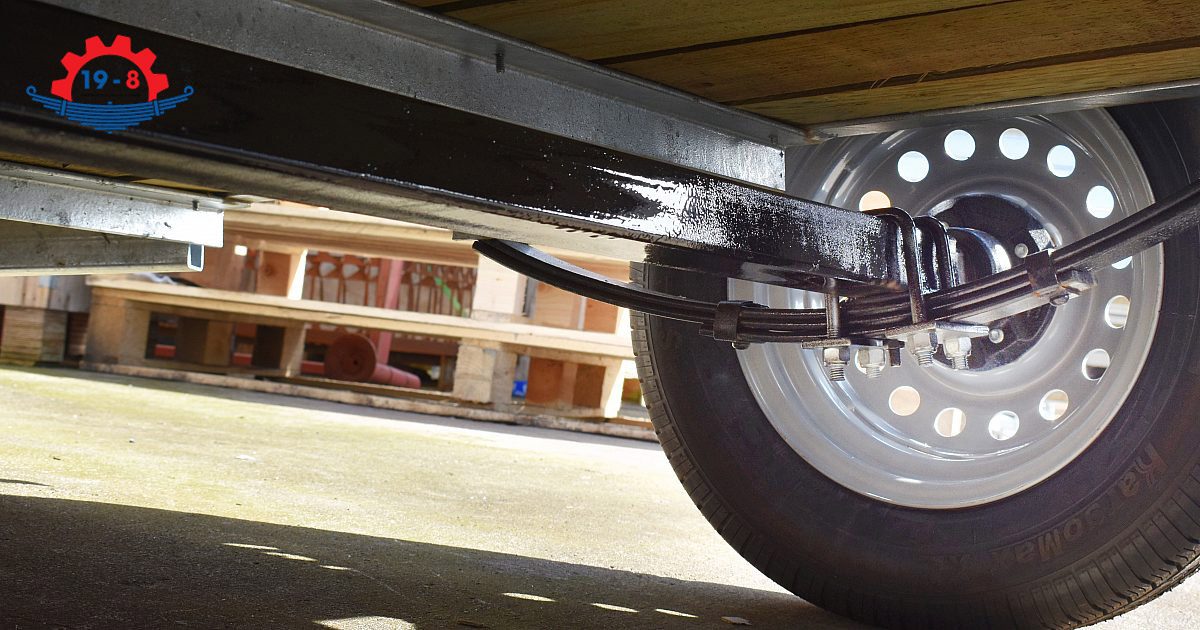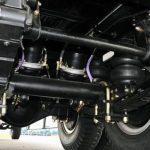Choosing the right leaf springs for your trailer is not a trivial task, as there are many factors to consider. In this guide, we will help you understand what trailer leaf springs are, how they work, and what factors to consider when choosing them. We will also provide some tips on how to install, maintain, and care for your trailer leaf springs.


Understanding Trailer Leaf Springs
They are long, flat pieces of metal that are curved into an arc shape and stacked together in a pack. The number of leaves in a group varies depending on the load capacity and flexibility of the spring. The ends of the leaves are attached to the trailer frame by hangers, while the middle of the pack is connected to the axle by a U-bolt.
There are two main types of trailer:
- Double-eye springs have eyes at both ends that are connected to hangers by bolts or shackles.
- Slipper springs have an eye at one end and a flat or hooked end at the other that slides into a hanger or rests on a wear pad.
They work by flexing under load and returning to their original shape when unloaded. This allows them to absorb shocks from road irregularities and distribute the weight of the trailer evenly across the axle.
They also help maintain the stability and alignment of the trailer by preventing excessive side-to-side or up-and-down movement. They are designed to work in pairs, so both sides of the axle should have the same type, size, and number of leaves.
Factors to Consider When Choosing
Trailers come in various shapes and sizes, and so do their leaf springs. The springs play a crucial role in supporting the trailer’s weight, providing a smooth ride, and ensuring overall safety. Picking the right leaf springs for your trailer is thus a vital task. Here, we delve into critical factors that you should consider.
Weight Capacity
Weight capacity is one of the most important factors to consider when choosing trailer leaf springs. The weight capacity of a leaf spring is the maximum amount of weight that it can support without breaking or deforming. The weight capacity of a leaf spring depends on its size, shape, thickness, and number of leaves. You need to match the weight capacity of your leaf spring with the gross vehicle weight rating (GVWR) of your trailer.
The GVWR is the total weight of your trailer plus its cargo, passengers, fluids, and accessories. You can find the GVWR of your trailer on its identification tag or in its owner’s manual.
To ensure safe towing, you should not exceed the weight capacity of your leaf spring or the GVWR of your trailer. Overloading your leaf spring can cause it to sag, crack, or break, which can compromise your trailer’s performance and safety. Overloading your trailer can also damage your axle, tires, brakes, and other components.
To avoid overloading your leaf spring or your trailer, you should always weigh your trailer before towing and distribute your cargo evenly across the trailer.
Trailer Type and Use
The specific type of trailer and its intended use can greatly influence the type of leaf springs required. For example:
- Utility trailers are used for hauling general cargo such as tools, equipment, furniture, etc. They usually have light to medium loads that are evenly distributed across the trailer. They require leaf springs that have moderate load capacity and flexibility.
- Boat trailers are used for transporting boats on water or land. They usually have heavy loads that are concentrated at the rear of the trailer. They require leaf springs that have high load capacity and stiffness.
- RV trailers are used for camping or living on the road. They usually have heavy loads that include appliances, furniture, water tanks, etc. They require leaf springs that have high load capacity and durability.
- Horse trailers are used for transporting horses or other livestock. They usually have heavy loads that include animals, feed, water, etc. They also have dynamic loads that shift during towing due to animal movement. They require leaf springs that have high load capacity and stability.
You should also consider how often and how far you use your trailer when choosing leaf springs. If you use your trailer frequently or for long distances, you need leaf springs that can withstand repeated stress and wear.


Number of Leaves
The number of leaves in a spring pack is more than just about its physical appearance. It plays a direct role in performance.
- Load capacity: Generally speaking, more leaves in a pack means higher load capacity. This is because more leaves can share the load and provide more support for the trailer. However, more leaves also mean more weight and cost, so you should not choose more leaves than you need.
- Ride comfort: Generally speaking, more leaves in a pack means a stiffer ride. This is because more leaves have less flexibility and absorb fewer shocks from the road. However, more leaves also mean more stability and alignment, so you should not choose fewer leaves than you need.
- When selecting the number of leaves in a pack for your trailer, balance load capacity with ride comfort. Additionally, factor in the type and condition of the roads you’ll be towing on. Fewer leaves might be suitable for smooth, flat roads, offering a softer ride. However, for rough and uneven terrains, opt for more leaves to ensure a sturdier ride.
Material and Durability
Another factor to consider when choosing trailer leaf springs is the material and durability of the leaves. The material and durability of the leaves affect the strength, weight, corrosion resistance, and lifespan of your leaf springs.
The most common material for trailer is steel. Steel is strong, inexpensive, and widely available. However, steel is also heavy, prone to rust, and susceptible to fatigue. To improve the durability of steel leaf springs, they are usually coated with paint or powder to prevent corrosion. They are also heat-treated to increase their strength and reduce their stress.
Installation Tips
Installing trailer leaf springs is not a difficult task, but it requires some tools, skills, and safety precautions. Here are some tips on how to install them:
- Before installing them, you should measure your old leaf springs and compare them with your new ones. You should make sure that they have the exact dimensions, such as length, width, thickness, eye size, etc. You should also make sure that they have the same type (double-eye or slipper) and number of leaves.
- To install them, you will need some tools such as jacks, jack stands, wrenches, sockets, pliers, hammers, etc. You will also need some hardware such as bolts, nuts, washers, shackles (for double-eye springs), U-bolts (for slipper springs),…


To install trailer leaf springs safely, you should follow these steps:
- Park your trailer on a level and solid surface.
- Chock the wheels of your trailer to prevent it from rolling.
- Disconnect your trailer from your tow vehicle.
- Raise your trailer with a jack until the tires are off the ground.
- Support your trailer with jack stands under the frame.
- Support your axle with another jack under the axle.
- Remove the old leaf springs by loosening and removing the bolts or shackles that connect them to the hangers and the U-bolts that connect them to the axle.
- Install the new leaf springs by reversing the removal process. Make sure to align the eyes or ends of the springs with the hangers and center the axle on the spring pack.
- Tighten all the bolts or shackles and U-bolts to the specified torque.
- Lower your axle with the jack until it rests on the new leaf springs.
- Lower your trailer with the jack until it rests on its tires.
- Remove the jack stands from under the frame.
- Reconnect your trailer to your tow vehicle.
- Check your trailer’s alignment and adjust if necessary.
Maintenance and Care
Maintaining and caring trailer leaf springs is essential to extend its life and ensure its performance and safety. Here are some tips on how to maintain and care:
- Inspect Regularly: Before every towing trip and every 12 months or 12,000 miles. Look for cracks, rust, or missing hardware and replace affected parts.
- Lubrication:
- Use grease or oil at contact points with hangers or wear pads.
- Use spray lubricant between leaves.
- Protect Against Weather:
- Shield with covers or tarps against rain, snow, and salt.
- Apply anti-rust sprays to prevent corrosion.
- Loading Practices:
- Avoid overloading; it leads to sagging or breaks.
- Avoid underloading; it causes bouncing or uneven wear.
- Adhere to the trailer’s GVWR and distribute the cargo evenly.


They are essential for your trailer’s performance and safety. By choosing the right trailer leaf springs, installing them properly, and maintaining and caring for them regularly, you can ensure a smooth and safe towing experience. We hope this guide has helped you understand what they are, how they work, and what factors to consider when choosing them.





